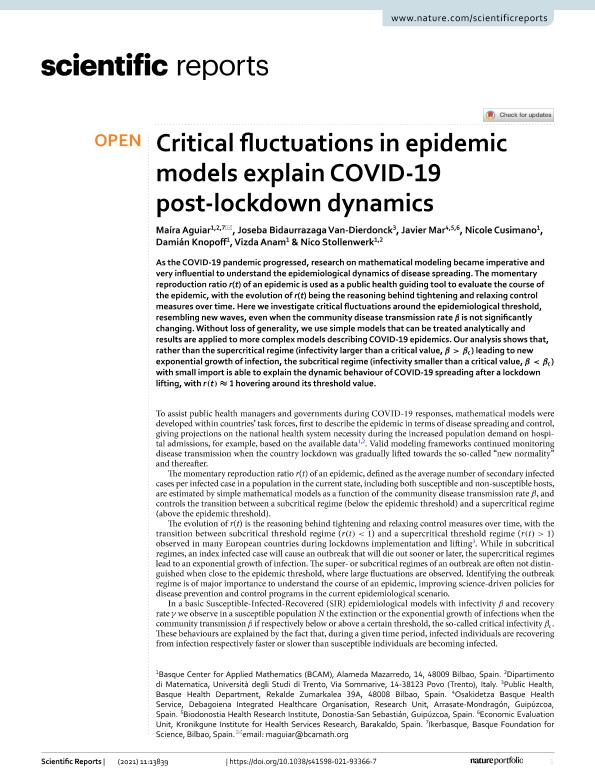Mostrar el registro sencillo del ítem
dc.contributor.author
Aguiar, Maíra
dc.contributor.author
Van Dierdonck, Joseba Bidaurrazaga
dc.contributor.author
Mar, Javier
dc.contributor.author
Cusimano, Nicole
dc.contributor.author
Knopoff, Damián Alejandro

dc.contributor.author
Anam, Vizda
dc.contributor.author
Stollenwerk, Nico
dc.date.available
2022-06-14T04:34:38Z
dc.date.issued
2021-12
dc.identifier.citation
Aguiar, Maíra; Van Dierdonck, Joseba Bidaurrazaga; Mar, Javier; Cusimano, Nicole; Knopoff, Damián Alejandro; et al.; Critical fluctuations in epidemic models explain COVID-19 post-lockdown dynamics; Nature Research; Scientific Reports; 11; 13839; 12-2021; 1-12
dc.identifier.uri
http://hdl.handle.net/11336/159641
dc.description.abstract
As the COVID-19 pandemic progressed, research on mathematical modeling became imperative and very influential to understand the epidemiological dynamics of disease spreading. The momentary reproduction ratio r(t) of an epidemic is used as a public health guiding tool to evaluate the course of the epidemic, with the evolution of r(t) being the reasoning behind tightening and relaxing control measures over time. Here we investigate critical fluctuations around the epidemiological threshold, resembling new waves, even when the community disease transmission rate β is not significantly changing. Without loss of generality, we use simple models that can be treated analytically and results are applied to more complex models describing COVID-19 epidemics. Our analysis shows that, rather than the supercritical regime (infectivity larger than a critical value, β> βc) leading to new exponential growth of infection, the subcritical regime (infectivity smaller than a critical value, β< βc) with small import is able to explain the dynamic behaviour of COVID-19 spreading after a lockdown lifting, with r(t) ≈ 1 hovering around its threshold value.
dc.format
application/pdf
dc.language.iso
eng
dc.publisher
Nature Research
dc.rights
info:eu-repo/semantics/openAccess
dc.rights.uri
https://creativecommons.org/licenses/by-nc-sa/2.5/ar/
dc.subject
EPIDEMIOLOGICAL MODELS
dc.subject
COVID-19
dc.subject
CRITICAL FLUCTUATIONS
dc.subject
STOCHASTIC MODELS
dc.subject.classification
Matemática Aplicada

dc.subject.classification
Matemáticas

dc.subject.classification
CIENCIAS NATURALES Y EXACTAS

dc.subject.classification
Epidemiología

dc.subject.classification
Ciencias de la Salud

dc.subject.classification
CIENCIAS MÉDICAS Y DE LA SALUD

dc.title
Critical fluctuations in epidemic models explain COVID-19 post-lockdown dynamics
dc.type
info:eu-repo/semantics/article
dc.type
info:ar-repo/semantics/artículo
dc.type
info:eu-repo/semantics/publishedVersion
dc.date.updated
2022-06-06T15:53:23Z
dc.identifier.eissn
2045-2322
dc.journal.volume
11
dc.journal.number
13839
dc.journal.pagination
1-12
dc.journal.pais
Reino Unido

dc.description.fil
Fil: Aguiar, Maíra. Basque Center for Applied Mathematics; España. Ikerbasque; España. Universita degli Studi di Trento; Italia
dc.description.fil
Fil: Van Dierdonck, Joseba Bidaurrazaga. Basque Health Department; España
dc.description.fil
Fil: Mar, Javier. Debagoiena Integrated Healthcare Organisation; España. Biodonostia Health Research Institute; España. Kronikgune Institute for Health Services Research; España
dc.description.fil
Fil: Cusimano, Nicole. Basque Center for Applied Mathematics; España
dc.description.fil
Fil: Knopoff, Damián Alejandro. Basque Center for Applied Mathematics; España. Consejo Nacional de Investigaciones Científicas y Técnicas; Argentina
dc.description.fil
Fil: Anam, Vizda. Basque Center for Applied Mathematics; España
dc.description.fil
Fil: Stollenwerk, Nico. Basque Center for Applied Mathematics; España. Universita degli Studi di Trento; Italia
dc.journal.title
Scientific Reports
dc.relation.alternativeid
info:eu-repo/semantics/altIdentifier/doi/http://dx.doi.org/10.1038/s41598-021-93366-7
dc.relation.alternativeid
info:eu-repo/semantics/altIdentifier/url/https://www.nature.com/articles/s41598-021-93366-7
Archivos asociados
